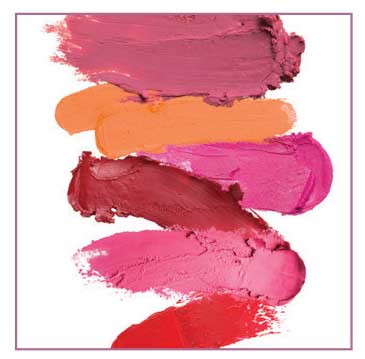 J Clin Aesthet Dermatol. 2023;16(1):18-24.
J Clin Aesthet Dermatol. 2023;16(1):18-24.
by Céline Couteau, PhD; Harona Diarra, PhD; Manon Lecoq; Aline Ali; Mélanie Bernet; and
Laurence Coiffard, PhD
All authors are with the University of Nantes, Faculty of Pharmacy in Nantes, France. Mr. Diarra is with University of Paris-Saclay, Faculty of Pharamacy in Châtenay-Malabry, France.
ABSTRACT: Two recent trends that have developed simultaneously are a mistrust of health products by some of the population and the growing popularity of essential oils. The objective of this study was to analyze recipes with essential oils found on the internet and to assess their level of photoprotective efficacy. Therefore, we conducted a study of 140 recipes for personal care and hygiene products that incorporate one or more essential oils.
This analysis revealed that numerous essential oils are called for in these recipes, derived from plants belonging to a wide diversity of botanical families. There was a significant difference (p=0.0026) in the number of essential oils listed in the recipes for facial care and body care recipes. There was also a statistically significant difference (p=2.54E-5) in the amount of essential oil to be added, expressed in drops, according to the type of product being made. A common characteristic of most of the recipes was the absence of any antimicrobial agents or antioxidants, which poses serious issues of preservation for the finished products. Recipes with essential oils pose many issues. The first issue lies in the quantities of the different raw materials to be incorporated; it influences the final essential oil concentration. The second issue concerns the adverse effects (photosensitization, for example) and contraindications (pregnant women, nursing women) of certain essential oils. Finally, it is not possible to carry out physicochemical testing raw materials and finish preparation.
Keywords: Recipes; DIY; Essential oils; Hygiene; Personal care
Do-it-yourself (DIY) is a practice that has been increasing over the last few years, which affects many fields, such as interior decorating, home insulation, jewelry manufacturing, furnitures, and, liquids for electronic cigarettes.1-3 Individuals can be motivated to make their own cosmetics for several reasons. First, the DIY approach in general, regardless of its purpose, is considered economical. In addition to this, making your own products can be a form of leisure4 that generates a feeling of pride in having created something useful for yourself.5 In the specific area of health products, there are also various other arguments, including the mistrust some people have in medical approaches, progress, and health professionals.6 The controversy was generated in 2004 after a publication on parabens has contributed greatly to this mistrust in the specific case of cosmetics.7 The suspicion then spread to the glycol ether family. It should be pointed out that this is a large family of molecules obtained by reacting ethylene oxide (e-series glycol ethers) or propylene oxide (p-series glycol ethers) with an alcohol. As several compounds in these two series, such as ethylene glycol monoethyl ether (EGEE), ethylene glycol monomethyl ether (EGME), and 2-methoxypropyl acetate (1PG2ME), for example, have been classified as toxic for reproduction,8 this has caused confusion about other members. Therefore, although phenoxyethanol, which is used as a preservative, is considered safe,9 it has been classified as a suspect ingredient. By-products of petroleum chemistry, such as paraffin, petroleum jelly, and liquid paraffin, are also suspect because some people consider them to be ingredients of concern. However, these products are made in such a way as to exclude substances like polycyclic hydrocarbons (PAHs), which are potentially carcinogenic, and to minimize mineral oil aromatic compounds (MOAHs). When they meet the requirements of the European Pharmacopoeia, these so-called “mineral” oils, and waxes do not pose a risk to users of cosmetic products containing them.10 At the same time, the popularity of essential oils continues to grow along with those wishing to produce their own cosmetics are attracted to recipes containing them.11-13 The purpose of this study was to analyze the composition of these products and to assess the risks of making them at home.
Methods
Using a search engine such as Google and the keywords “homemade recipe” and “essential oils”, we searched the internet for DIY cosmetics recipes. We analyzed the composition of the ones we found, which allowed us to examine and discuss the problems related to their dissemination and use.
Statistical analysis. Not all the samples in this study were normally distributed which were checked using a Shapiro-Wilk test. We used non-parametric methods to make the statistical comparisons in this study. A Kruskal-Wallis nonparametric test was used to determine whether there were statistically significant differences between the medians of the data. The significance level, or alpha, was set at 0.05 (5%). When a significant difference was observed with this test, we used Dunn’s test with Bonferroni adjustment to identify which of the samples were significantly different. These statistical comparison tests were carried out in R software, using RStudio.
Results
We found 140 recipes, most of which are for facial care creams (Figure 1). We subdivided each major product category into subcategories (Table 1). Among the ingredients of these recipes, sixty different essential oils from 23 distinct botanical families are listed. The essential oils most frequently found are those of lavender, tea tree, rosewood, carrot, grapefruit, lemon, and mint (Figure 2). The most represented botanical families are Rutaceae, Myrtaceae and Lamiaceae (Figure 3).

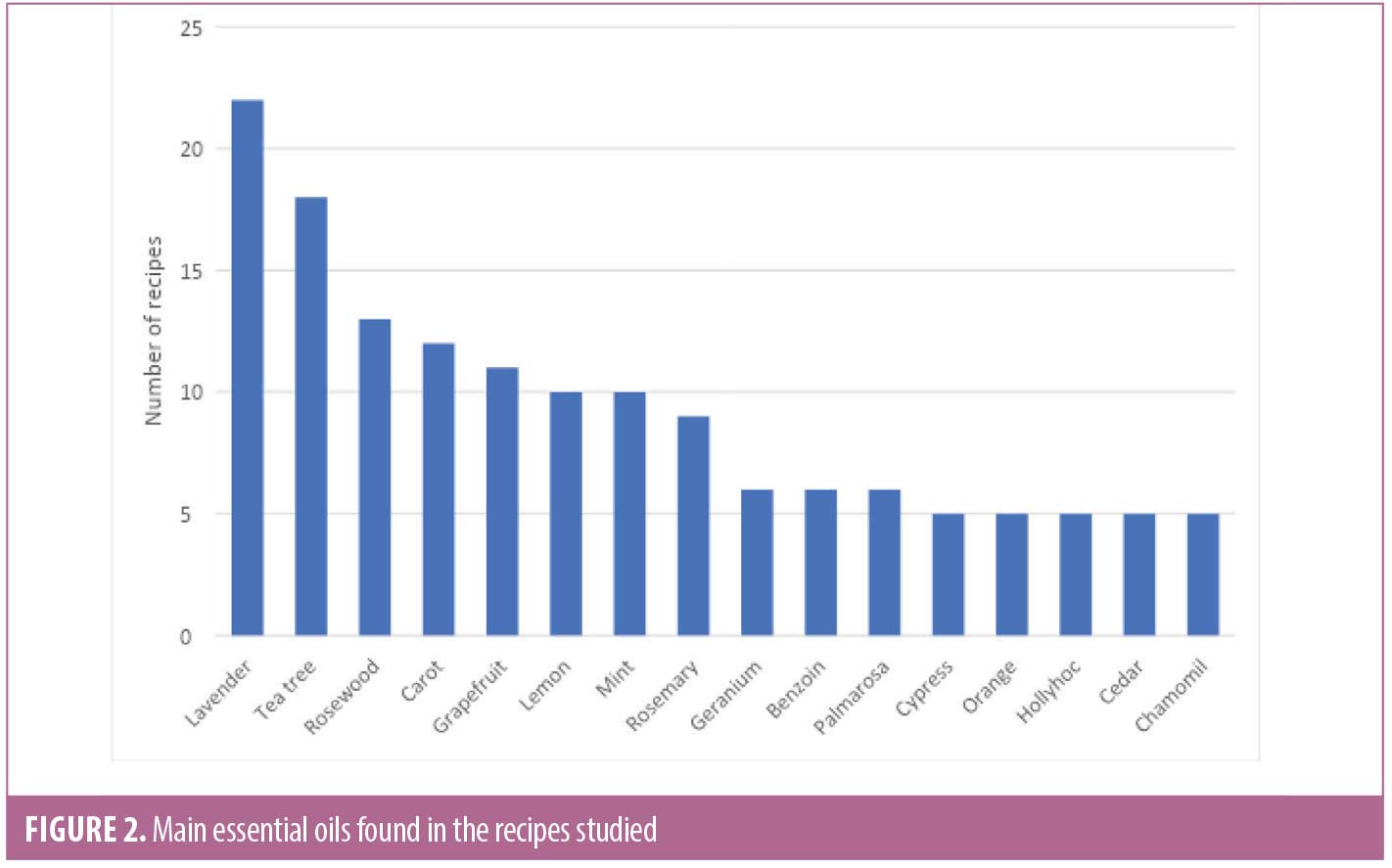
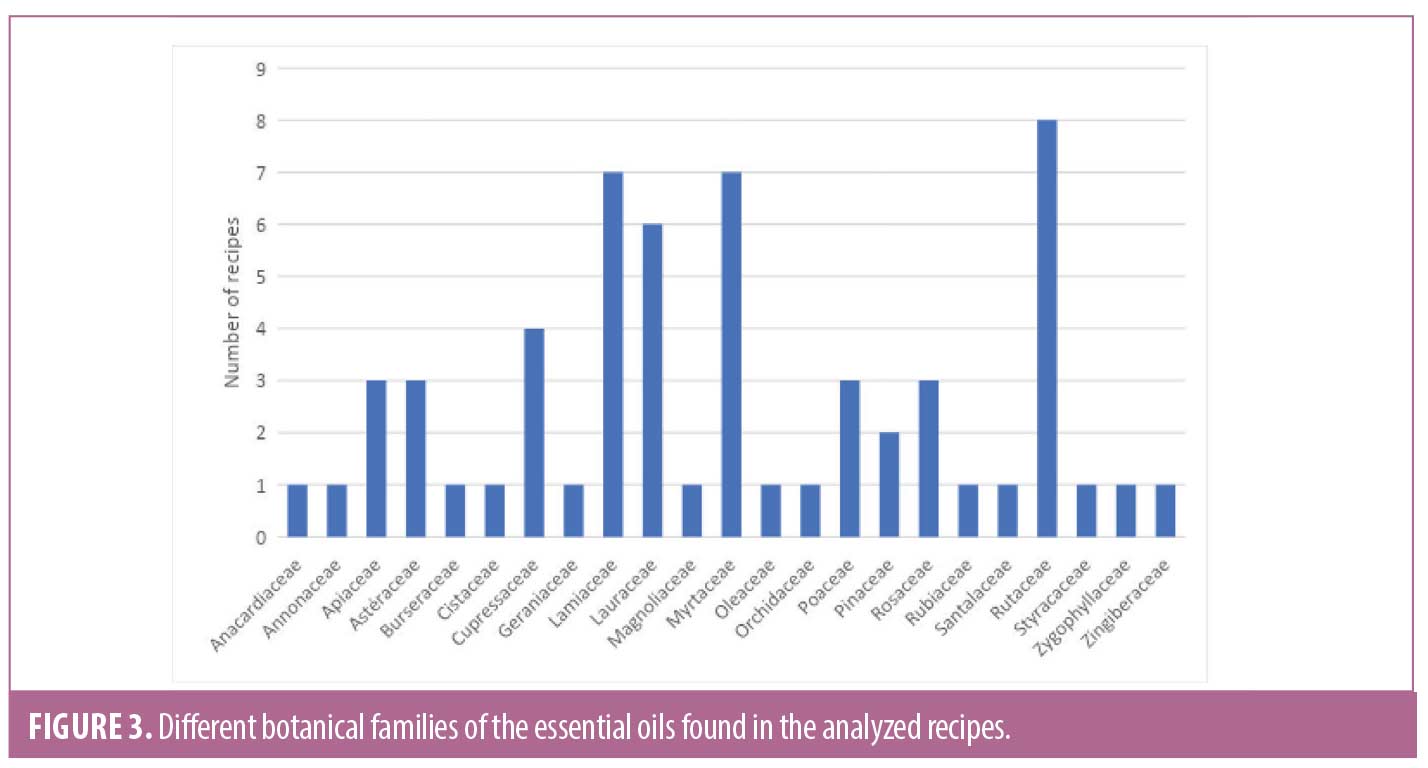

Results for facial, body, and hair care product recipes. Most of the recipes for facial care products are emulsions, hence the concomitant presence of water or hydrolates and fatty substances (butters and oils) (Figure 4). There are also recipes with excipients consisting of mixtures of fatty substances (10 recipes), yogurt, or fresh cream (Figure 4). One recipe for an anti-acne remedy consists of essential oils of rosemary, noble laurel, tea tree, and lavender, without any excipient to dilute this mixture.
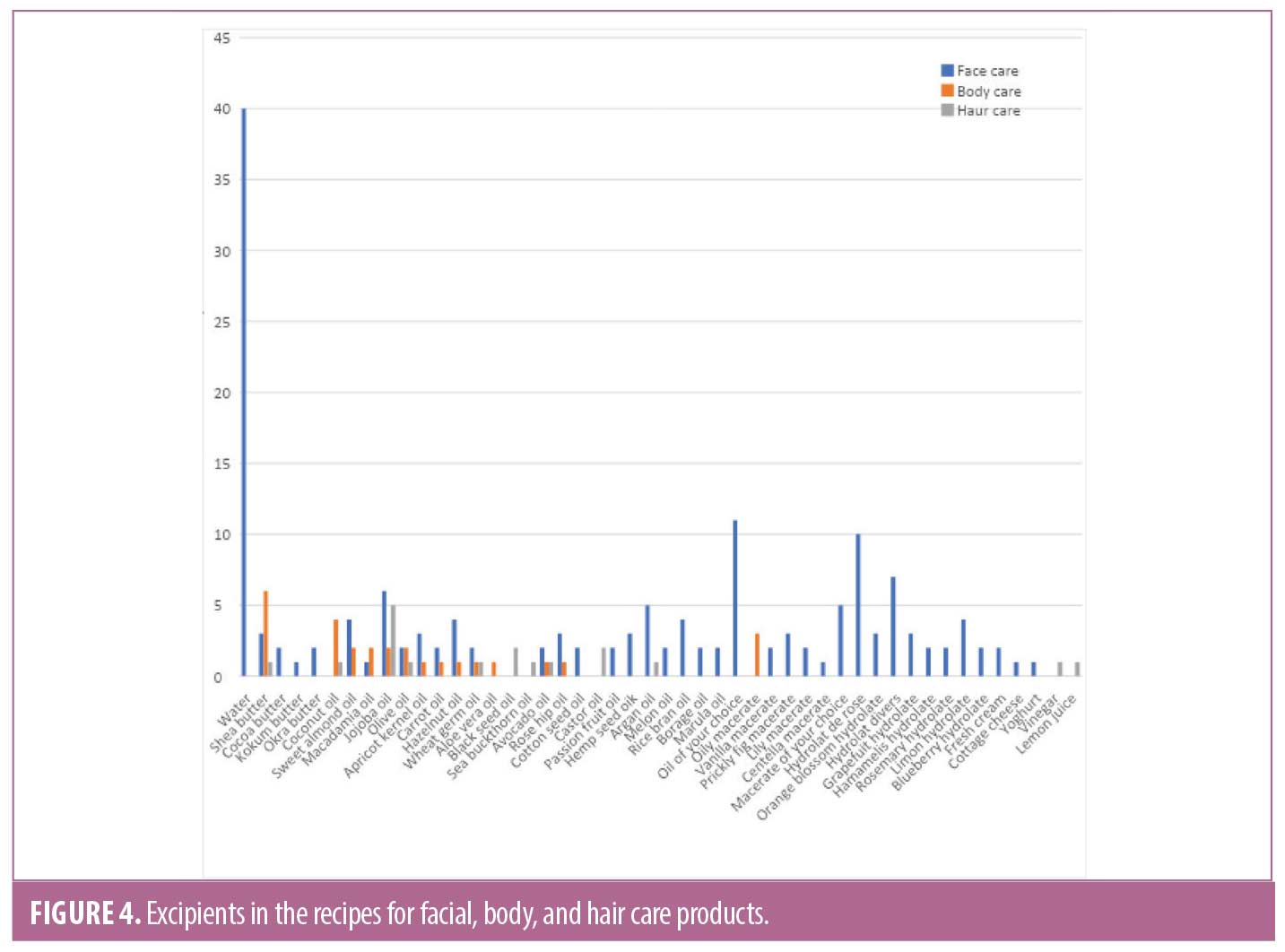
As regards the recipes for body care products, the excipients are lipophilic ones (Figure 4), consisting of shea butter, various vegetable oils, or oily macerates, in which one or more essential oils are dispersed.
Finally, those hair care recipes for anti-hair loss products are mainly dispersions of essential oils in a vegetable oil or a mixture of vegetable oils. One exception is a recipe that combines cider vinegar, lemon juice, and rosemary essential oil.
The various essential oils found in the recipes for skin and hair care products are presented in Figure 5.
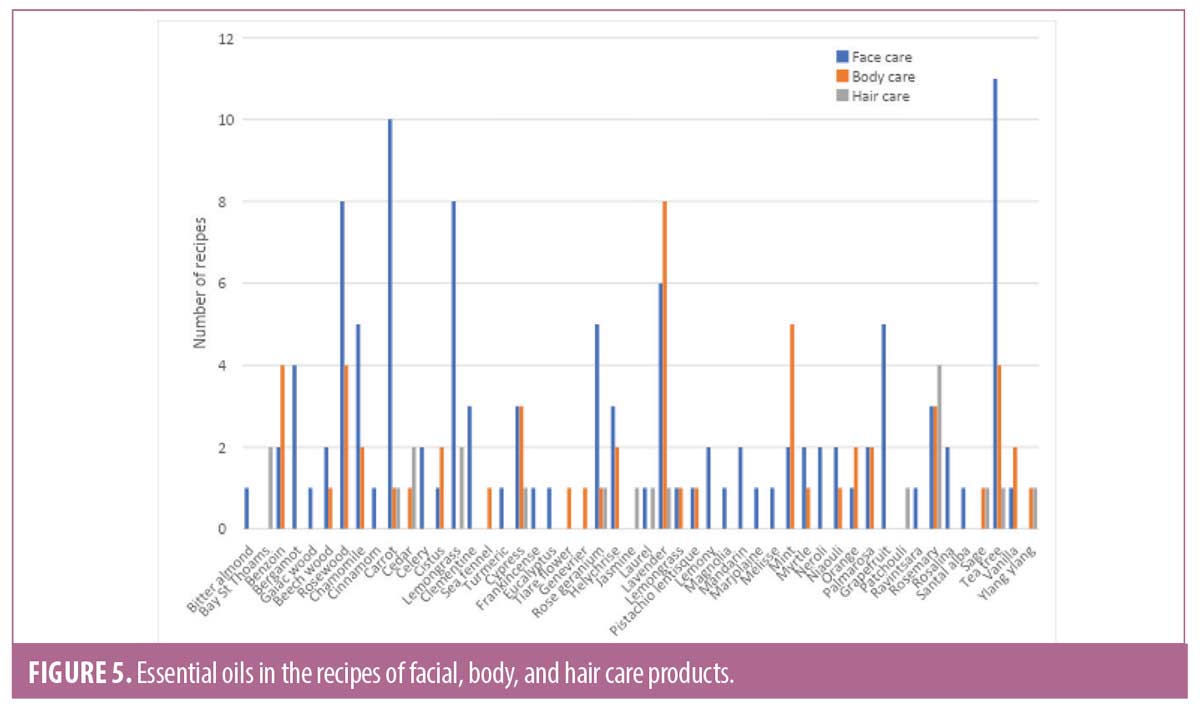
Results for hygiene product recipes. Regarding facial hygiene products, DIYers can find recipes for micellar water and make-up removal milks and mousses (Figure 6).

Most body hygiene products for which we found recipes are aqueous soap solutions to which one or more essential oils are added. The choice of the essential oil to be used is sometimes left up to the person making the recipe (Figure 6).
Finally, the hair and scalp hygiene recipes were for liquid forms corresponding to milks containing both water and oil, or solid shampoos produced using sodium cocoyl isethionate.14,15
The various essential oils found in the hygiene product recipes are presented in Figure 7.
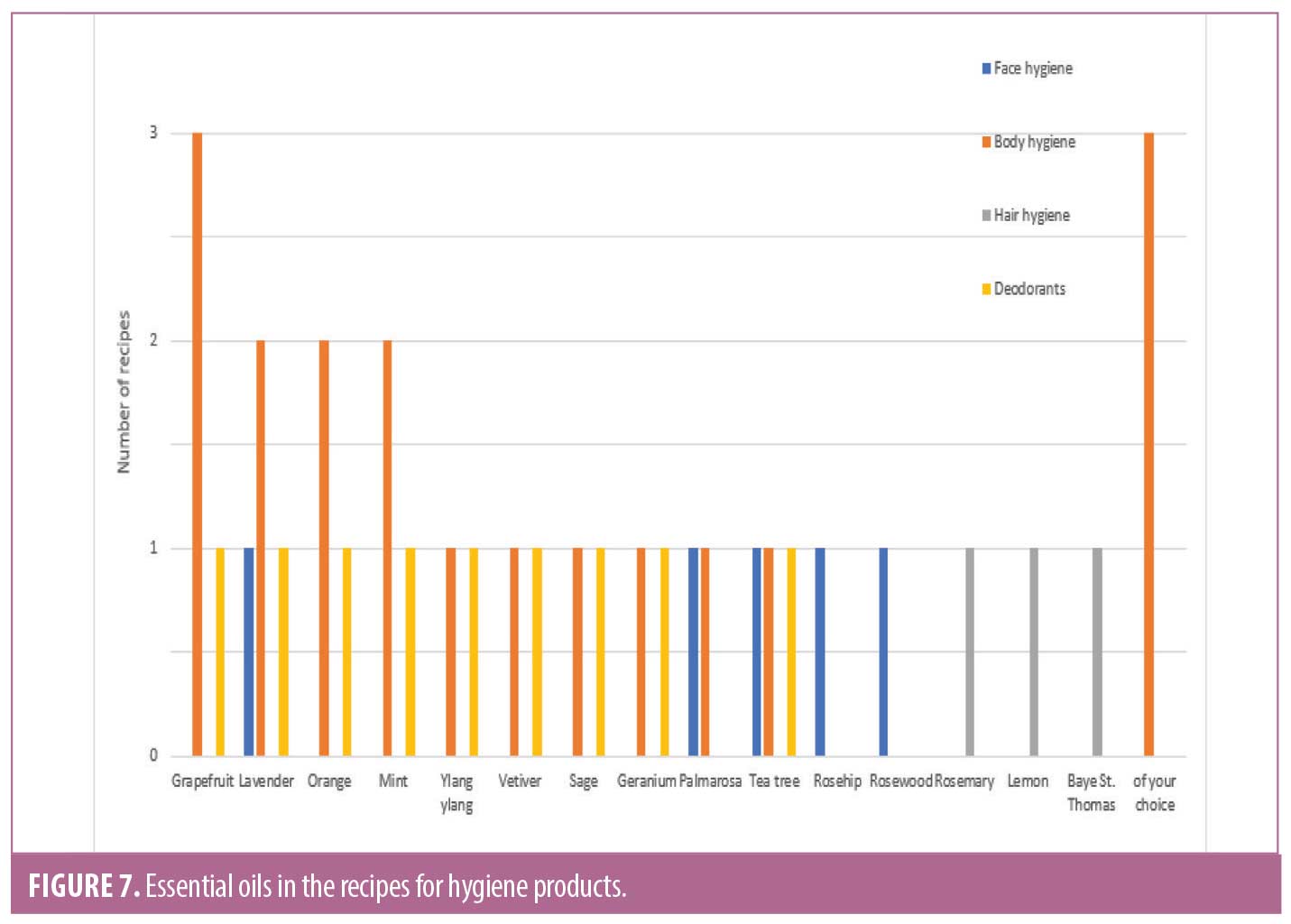
Results for deodorant recipes. The deodorant recipes analyzed are basically types of balm consisting of absorbent powders, such as clay or sodium bicarbonate, and essential oils dispersed in a mixture of hydrophobic excipients (Figure 6). The essential oils found in these deodorant recipes are presented in Figure 7.
Discussion
General issues. A blog disseminates content written by its author, who, in most cases, is not an expert in the field they are writing about.16 In the present case, the formulas of the recipes have not been validated by any specialist in cosmetic formulation and/or aromatherapy. Some recipes, such as those for acne treatment, are actually drugs as they are presented with therapeutic indications.
Problems with measures used for raw materials. Unlike the recipes for sunscreens, toothpastes, and eye cosmetics that we previously studied,17-19 the quantities of the various raw materials in the present recipes, apart from the essential oils, are mainly expressed in grams or milliliters. However, we still found some that are given in tablespoons or teaspoons, which in practice leads to total inaccuracy of the final concentrations of each ingredient. Indeed, spoons can vary greatly in shape, with capacities ranging from single to triple for tablespoons, for example.20 In a few very rare cases, the recipe does not specify any amounts for the different ingredients in the recipe.
The amounts of essential oils in the recipes are given in drops which causes the dosage to fluctuate greatly. The people who make the recipes do not have a standardized dropper like the one described in the European Pharmacopoeia monograph 2.1.1, entitled Droppers, which stipulates that 20 drops of water have a mass of 1000 ± 50mg. The amount of essential oil to be added varies greatly, with occasionally extreme values like the 440 drops of mint essential oil required in a recipe for a facial care product. If we compare the recipes for the care products with those for the hygiene products (Figure 8), we can conclude that there is a statistically significant difference in the number of drops required (p=4.75E-10). Dunn’s statistical test enabled us to pick out a significant difference between the recipes for hair hygiene products and those for the other four types of products for facial and body hygiene (Figure 9), as well as for facial care (Table 2). Also, the recipes for body care products are significantly different from the others (Figure 10) and contain more essential oils (Table 3).
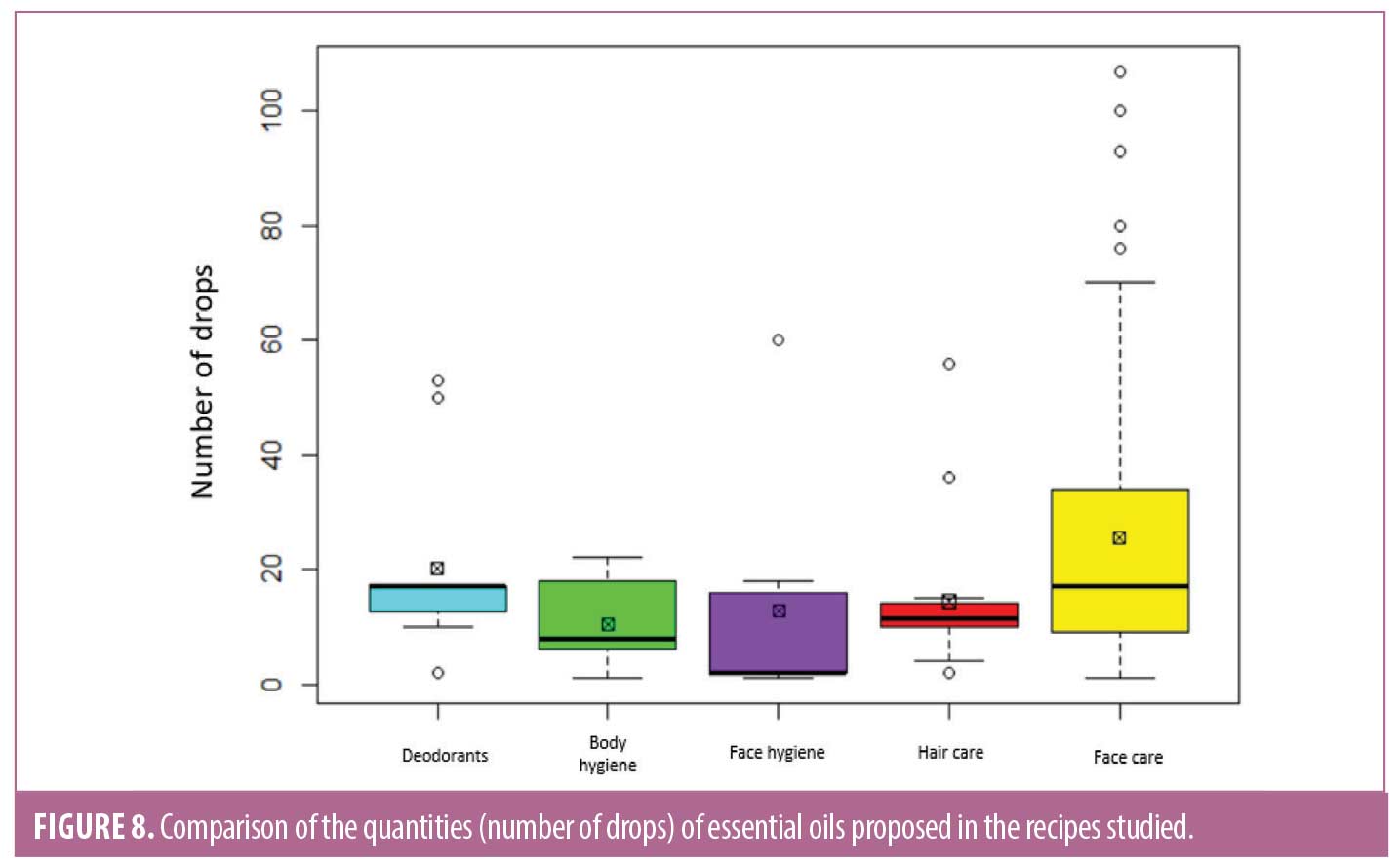
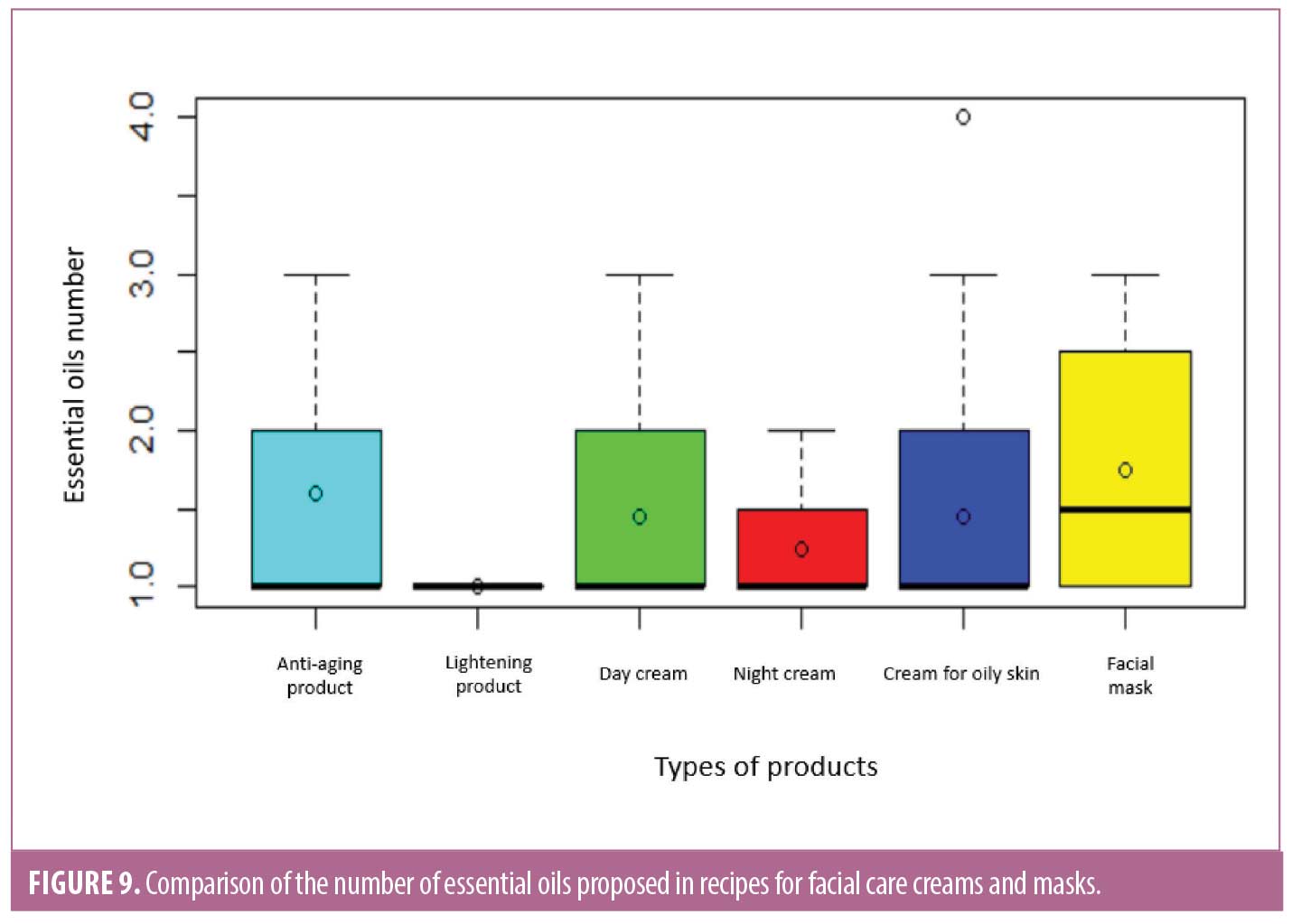
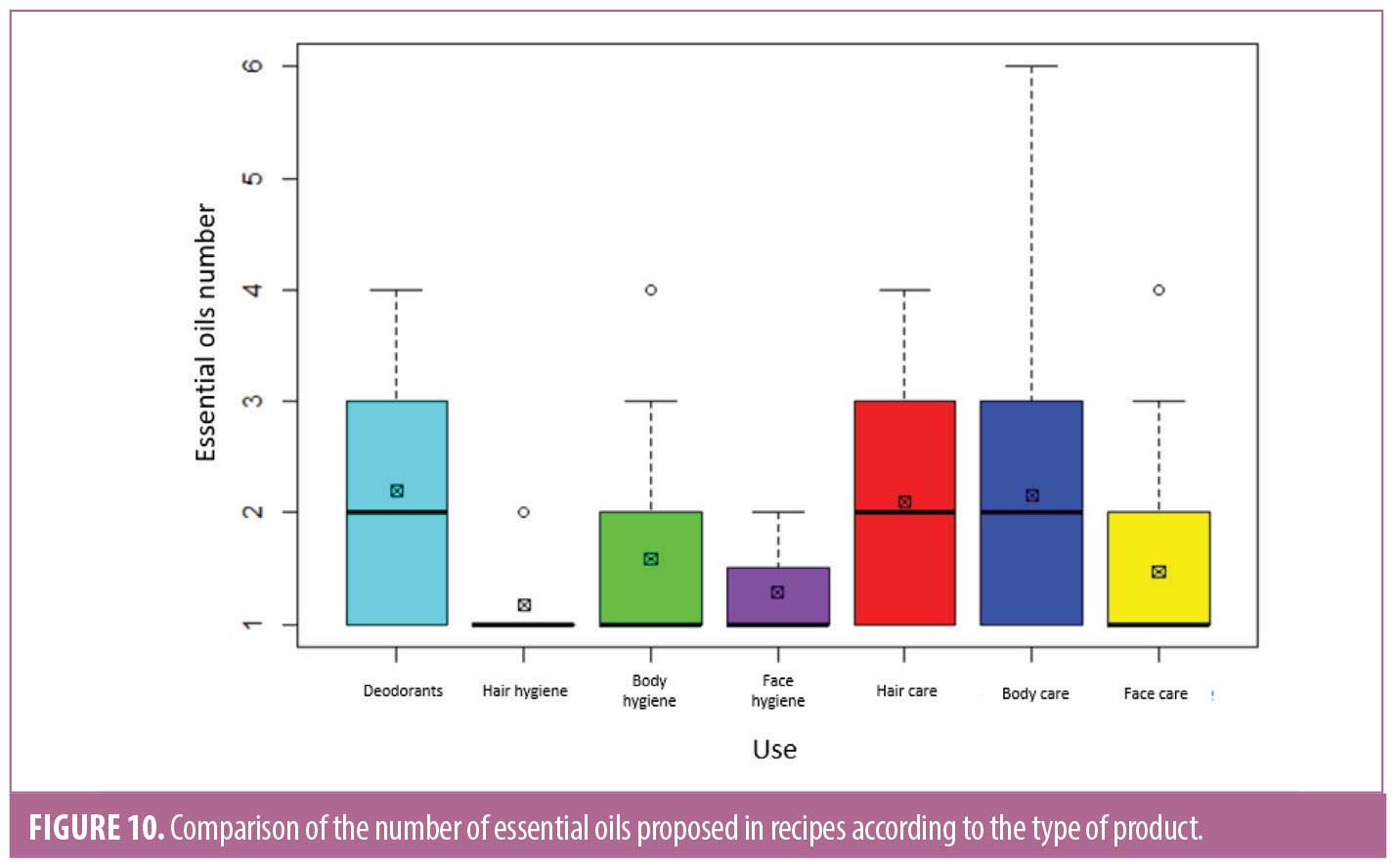


Problems posed by essential oils. The different recipes propose the addition of one or more essential oils. Among the different recipes for facial care products, the difference in the number of different essential oils is not significant (p=0.635; Figure 9). On the contrary, there is a significant difference (p=0.0026) between the recipes for facial care and body care products (Figure 10).
One of the issues that these recipes pose is our lack of knowledge about the possible interactions of essential oils with each other and/or the excipient.
Moreover, the use of such recipes does not eliminate the risk of adverse effects. All the essential oils identified during this study can cause contact allergies and allergic contact dermatitis21-25 or even photosensitization phenomena, which is a characteristic of citrus essential oils.26-28 Some recipe websites specify that essential oils without furocoumarins must be used. This is a wise recommendation, as it is known that these molecules are responsible for phototoxic and potentially carcinogenic effects.29
Problems with preservation of the finished products. The recipes studied would not be expected to keep well. The only antioxidant mentioned is vitamin E. In addition, two antimicrobial preservatives are listed: Cosgard® and Isocide®, which correspond to aqueous solutions of benzyl alcohol and dehydroacetic acid (Table 3). Only a minority of the recipes contain such preservatives (24 of the recipes studied), while many contain water or hydrolates. Preservation, therefore, relies on essential oils known to be antimicrobial, which is indeed the case of the most frequent ones in the recipes studied.30-45 Studies show that the inclusion of essential oil(s) could allow a reduction in the concentration of certain preservatives such as 1,3-dimethylol-5,5-dimethylhydantoin and 3-iodo-2-propynyl butylcarbamate (while maintaining the same efficiency) by adding lavender and tea tree essential oils to the medium at a concentration of 0.5% each.46 Therefore, it would appear that there is a synergy between essential oils and the preservatives authorized by European regulations. However, in the recipes studied, the situation is very different insofar as preservation is based on only a single essential oil and, when the recipe specifies only two drops for example, this is below 0.5%. It is also known that the oligotrophic nature of hydrosols and antimicrobial properties of their essential oils do not prevent microbiological spoilage.47 Consider the five most common essential oils found in the recipes studied. Lavendula angustifolia essential oil was demonstrated to have in-vitro activity against both antibiotic-resistant Staphylococcus aureus and Enterococcus faecalis at a concentration of less than 1%.48 Tea tree oil is an essential oil, steam-distilled from Melaleuca alternifolia. Terpinen-4-ol is a major component which exhibits strong antimicrobial. But it is necessary to use high concentration in order to observe an real efficacy. A study showed that tea tree oil used at a 10% concentration has effects comparable with those of topical mupirocin against the bacterium S. aureus.49 Antimicrobial activity against Cutibacterium acnes had a concentration-dependent effect with microbial growth inhibitory activity in all assays at 2% v/v.50 Essential oil of grapefruit rich in monoterpenes with the major component being d-limonene; it showed in vitro a strong antibacterial activity against Bacillus cereus, Enterococus faecalis, Escherichia coli, Klebsiella pneumoniae, Pseudococcus sp., Salmonella thyphimurium, Shigella flexneri, and Staphylococcus aureus, and a strong antifungal activity against Aspergillus niger, Candida albicans, Cladosporium cucumerinum, Penicillium sp.51 Rosewood essential oil rich in linalool has antifungal properties.52 It should be emphasized that although the antimicrobial activity is well established, the in-vivo effect is significantly weaker compared to synthetic compounds.53
The same applies to the prevention of rancidification. Only 15 recipes propose using vitamin E as an antioxidant, although many of the oils recommended, such as olive, avocado, or borage, are oxidizable.54-56 The lavender essential oil presented antioxidant activity. Nonetheless, when compared to the Trolox standard, a water-soluble analog of vitamin E, the results suggested that these antioxidant activities are considered low to moderate.57 Grapefruit essential oil has very poor antioxidant activity.58 The same applies to rosewood and carot essential oil.59,60 The best results are obtained with tea tree essential oil which would have a greater efficiency than those of BHT.61
Finally, no prior studies have allowed the expiration date of such preparations to be predicted.
References
- Colin C. Williams CC. A lifestyle choice? Evaluating the motives of do-it-yourself (DIY) consumers. Int J Retail Distrib Manag. 2004; 32(5):270–278
- Cox S, Leigh NJ, Vanderbush TS, et al. An exploration into “do-it-yourself” (DIY) e-liquid mixing: Users’ motivations, practices and product laboratory analysis. Addictive Behav Rep. 2019; 100151, ISSN 2352-8532, https://doi.org/10.1016/j.abrep.2018.100151.
- Sarpong D, Ofosu G, Botchie D, et al. Do-it-yourself (DiY) science: The proliferation, relevance and concerns. Technol Forecasting Soc Change. 2020; 158, 120127, ISSN 0040–1625.
- Auger C. Portes entrouvertes sur l’industrie du loisir créatif. Gestion. 2014 ;1 :11–15.
- Stébé JM, Marchal H. Acquérir et rénover une maison au cœur d’un village. Regards sur un territoire émergent : le pré-urbain. Ethnol fr. 2016 ;46 :721–731.
- Jaiswal J, Halkitis PN. Towards a More Inclusive and Dynamic Understanding of Medical Mistrust Informed by Science. Behav Med. 2019;45:79–85.
- Darbre PD, Aljarrah A, Miller WR, et al. Concentrations of parabens in human breast tumours. J Appl Toxicol. 2004;24:5–13.
- Kelsey JR. Ethylene oxide derived glycol ethers: A review of the alkyl glycol ethers potential to cause endocrine disruption. Regul Toxicol Pharmacol. 2021;30:105113.
- Final version of the opinion on Phenoxyethanol in cosmetic products. Regul Toxicol Pharmacol. 2016 Dec;82:156.
- Petry T, Bury D, Fautz R, et al. Review of data on the dermal penetration of mineral oils and waxes used in cosmetic applications. Toxicol Lett. 2017;280:70–78.
- Ramsey JT, Shropshire BC, Nagy TR, et al. Essential Oils and Health. Yale J Biol Med. 2020;93:291–305.
- Allard ME, Katseres J. Using essential oils to enhance nursing practice and for self-care. Nurse Pract. 2018;43:39–46.
- Tillett J, Ames D. The uses of aromatherapy in women’s health. J Perinat Neonatal Nurs. 2010;24:238–245.
- Korting HC, Lukacs A, Hamm D, et al. In-use tolerability of two new syndet bars with sodium cocoyl isethionate, disodium lauryl sulfosuccinate and wheat starch as major ingredients in differing relations: results of a cross-over trial. Int J Cosmet Sci. 1992;14:277–282.
- Ghosh S, Blankschtein D. Why is sodium cocoyl isethionate (SCI) mild to the skin barrier? – An in vitro investigation based on the relative sizes of the SCI micelles and the skin aqueous pores. J Cosmet Sci. 2007;58:229–244.
- Ansermet F, Giacobino A. Paniques biotechnologiques. La Cause du Désir. 2016 ; 93 :55–62.
- Couteau C, Dupont C, Paparis E, et al. Demonstration of the dangerous nature of ‘homemade’ sunscreen recipes. J Cosmet Dermatol. 2021;20:1788–1794
- Couteau C, Domejean S, Lecoq M, et al. A study of 84 homemade toothpaste recipes and the problems arising from the type of product. Br Dent J. 2021 Apr 8.
- Couteau C, Girard E, Coiffard L. An analysis of 275 DIY recipes for eye cosmetics and their possible safety issues. Int J Cosmet Sci. 2022 Apr 9.
- Falagas ME, Vouloumanou EK, Plessa E, et al. Inaccuracies in dosing drugs with teaspoons and tablespoons. Int J Clin Pract. 2010;64:1185.
- de Groot A, Schmidt E. Essential Oils, Part V: Peppermint Oil, Lavender Oil, and Lemongrass Oil. Dermatitis. 2016;27:325–332.
- de Groot AC, Schmidt E. Tea tree oil: contact allergy and chemical composition. Contact Dermatitis. 2016;75:129–143.
- de Groot AC, Schmidt E. Essential Oils, Part I: Introduction. Dermatitis. 2016;27:39–42.
- de Groot AC, Schmidt E. Essential Oils, Part VI: Sandalwood Oil, Ylang-Ylang Oil, and Jasmine Absolute. Dermatitis. 2017;28:14–21.
- Herro E, Jacob SE. Mentha piperita (peppermint). Dermatitis. 2010;21:327–329.
- Naganuma M, Hirose S, Nakayama Y, et al. A study of the phototoxicity of lemon oil. Arch Dermatol Res.1985;278:31–36.
- Kejlová K, Jírová D, Bendová H, et al. Phototoxicity of essential oils intended for cosmetic use. Toxicol In Vitro. 2010;24:2084–2089.
- Kejlová K, Jírová D, Bendová H, et al. Phototoxicity of essential oils intended for cosmetic use. Toxicol In Vitro. 2010;24:2084–2089.
- Kerekes D, Csorba A, Gosztola B, et al. Furocoumarin Content of Fennel-Below the Safety Threshold. Molecules. 2019;24:2844.
- Mekonnen A, Yitayew B, Tesema A, et al. In Vitro Antimicrobial Activity of Essential Oil of Thymus schimperi, Matricaria chamomilla, Eucalyptus globulus, and Rosmarinus officinalis. Int J Microbiol. 2016;2016:9545693.
- Cavanagh HM, Wilkinson JM. Biological activities of lavender essential oil. Phytother Res.2002;16:301–308.
- Carson CF, Hammer KA, Riley TV. Melaleuca alternifolia (Tea Tree) oil: a review of antimicrobial and other medicinal properties. Clin Microbiol Rev. 2006;19:50–62.
- Teles AM, Silva-Silva JV, Fernandes JMP, et al. Aniba rosaeodora (Var. amazonica Ducke) Essential Oil: Chemical Composition, Antibacterial, Antioxidant and Antitrypanosomal Activity. Antibiotics (Basel). 2020;10:24.
- Ma T, Luo J, Tian C, et al. Influence of technical processing units on chemical composition and antimicrobial activity of carrot (Daucus carrot L.) juice essential oil. Food Chem. 2015;170:394–400.
- Deng W, Liu K, Cao S, et al. Chemical Composition, Antimicrobial, Antioxidant, and Antiproliferative Properties of Grapefruit Essential Oil Prepared by Molecular Distillation. Molecules. 2020;25:217.
- Geraci A, Di Stefano V, Di Martino E, et al. Essential oil components of orange peels and antimicrobial activity. Nat Prod Res. 2017;31:653–659.
- McKay DL, Blumberg JB. A review of the bioactivity and potential health benefits of peppermint tea (Mentha piperita L.). Phytother Res. 2006;20:619–633.
- Ghasemzadeh RM, Hosseinzadeh H. Therapeutic effects of rosemary (Rosmarinus officinalis L.) and its active constituents on nervous system disorders. Iran J Basic Med Sci. 2020;23:1100–1112.
- Sienkiewicz M, Głowacka A, Kowalczyk E, et al. The biological activities of cinnamon, geranium and lavender essential oils. Molecules. 2014;19:20929–20940.
- Orchard A, Viljoen A, van Vuuren S. Antimicrobial Essential Oil Combinations to Combat Foot Odour. Planta Med. 2018;84:662–673.
- Prashar A, Hili P, Veness RG, et al. Antimicrobial action of palmarosa oil (Cymbopogon martinii) on Saccharomyces cerevisiae. Phytochem. 2003;63:569–575.
- Ismail A, Mancini E, De Martino L, et al. Chemical composition and biological activities of Tunisian Cupressus arizonica Greene essential oils. Chem Biodivers. 2014;11:150–160.
- Simona J, Dani D, Petr S, et al. Edible Films from Carrageenan/Orange Essential Oil/Trehalose-Structure, Optical Properties, and Antimicrobial Activity. Polymers (Basel). 2021;13:332.
- Oliva A, Garzoli S, Sabatino M, et al. Chemical composition and antimicrobial activity of essential oil of Helichrysum italicum (Roth) G. Don fil. (Asteraceae) from Montenegro. Nat Prod Res. 2020;34:445–448.
- Huang K, Liu R, Zhang Y, et al. Characteristics of two cedarwood essential oil emulsions and their antioxidant and antibacterial activities. Food Chem. 2021;346:128970.
- Kunicka-Styczyńska A, Sikora M, Kalemba D. Antimicrobial activity of lavender, tea tree and lemon oils in cosmetic preservative systems. J Appl Microbiol. 2009;107:1903–1911.
- Labadie C, Cerutti C, Carlin F. Fate and control of pathogenic and spoilage micro-organisms in orange blossom (Citrus aurantium) and rose flower (Rosa centifolia) hydrosols. J Appl Microbiol. 2016;121:1568–1579.
- Nelson RRS. In vitro activities of five plant essential oils against methacillin-resistant Staphylococcus aureus and vancomycin-resistant Enterococcus faecium. J Anti- microb Chemother. 1997 ;40:305–306.
- Pazyar N, Yaghoobi R, Bagherani N, et al. A review of applications of tea tree oil in dermatology. Int J Dermatol. 2013;52:784–790.
- Ossa-Tabares JC, Llanos CJ, García AM. Evaluation of tea tree oil physicochemical features and its antimicrobial activity against Cutibacterium acnes (Propionibacterium acnes) ATCC 6919. Biomedica. 2020;40:693–701.
- Dosoky NS, Setzer WN. Biological Activities and Safety of Citrus spp. Essential Oils. Int J Mol Sci. 2018;19:1966.
- Ali A, Radwan MM, Wanas AS, et al. Repellent Activity of Carrot Seed Essential Oil and Its Pure Compound, Carotol, Against Mosquitoes. J Am Mosq Control Assoc. 2018;34:272–280.
- Wińska K, Mączka W, Łyczko J, et al. Essential Oils as Antimicrobial Agents-Myth or Real Alternative? Molecules. 2019;24:2130.
- Casal S, Malheiro R, Sendas A, et al. Olive oil stability under deep-frying conditions. Food Chem Toxicol. 2010;48:2972–2979.
- Segovia FJ, Hidalgo GI, Villasante J, et al. Avocado Seed: A Comparative Study of Antioxidant Content and Capacity in Protecting Oil Models from Oxidation. Molecules. 2018;23:2421.
- Asadi-Samani M, Bahmani M, Rafieian-Kopaei M. The chemical composition, botanical characteristic and biological activities of Borago officinalis: a review. Asian Pac J Trop Med. 2014;7S1:S22–S28.
- Insawang S, Pripdeevech P, Tanapichatsakul C, et al. Essential Oil Compositions and Antibacterial and Antioxidant Activities of Five Lavandula stoechas Cultivars Grown in Thailand. Chem Biodivers. 2019;16:e1900371.
- Deng W, Liu K, Cao S, et al. Chemical Composition, Antimicrobial, Antioxidant, and Antiproliferative Properties of Grapefruit Essential Oil Prepared by Molecular Distillation. Molecules. 2020;25:217.
- Teles AM, Silva-Silva JV, Fernandes JMP, et al. Aniba rosaeodora (Var. amazonica Ducke) Essential Oil: Chemical Composition, Antibacterial, Antioxidant and Antitrypanosomal Activity. Antibiotics (Basel). 2020;10:24.
- Alves-Silva JM, Zuzarte M, Gonçalves MJ, et al. New Claims for Wild Carrot (Daucus carota subsp. carota) Essential Oil. Evid Based Complement Alternat Med. 2016;2016:9045196.
- Yasin M, Younis A, Javed T, et al. River Tea Tree Oil: Composition, Antimicrobial and Antioxidant Activities, and Potential Applications in Agriculture. Plants (Basel). 2021;10(10):2105.

